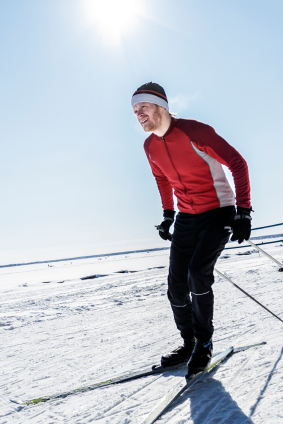
When is winter sun as dangerous as summer sun?
In winter Canadians still spend a lot of time outdoors and are exposed to the sun. Yet only one in four Canadians are likely to apply sunscreen when going outside in the winter.
Levels of radiation are influenced by factors including the sun’s elevation, cloud cover, altitude and reflection. Winter conditions can create an intense UV radiation environment: snow reflects as much as 80% of UV radiation (much higher than water or dry beach sand). Overexposure to sun can’t always be seen or felt, so it’s easy to underestimate the sunlight’s reflection from the snow when skiing and snowboarding—even on a cold day.
Why should you care? UV radiation is the leading factor in the development of skin cancers, yet it is the most preventable cause. The UV from sun in winter can be a major concern especially at altitude for the face and head (unless you like to skin in shorts). While basal and squamous cell cancers are more likely a result from winter sun exposure, the overriding concern for UV exposure year-round is melanoma, the deadliest form of skin cancer. The majority of melanomas (90%) are caused by exposure to UV light and sunlight.
Melanoma’s Growth
Melanoma is characterized by the uncontrolled growth of pigment-producing cells (melanocytes) located in the skin. Metastatic or advanced melanoma is potentially the deadliest form of the disease, and occurs when cancer spreads beyond the surface of the skin to other areas of the body.
Melanoma is one of the fastest increasing cancers worldwide. In Canada, this form of skin cancer has more than tripled over the last 30 years and continues to increase*. Melanoma is one of the few cancers to affect young adults, and is the second most common cancer amongst 15-34 year olds.
The lifetime risk of melanoma for men – where it is most commonly found on backs – is higher than in women**, who tend to have it on their legs. Survival rates are high if it is detected early. Unlike many cancers, melanoma is generally quite visible on the skin. In its late stages, the median survival rate is less than one year.
Men Most at Risk
Results from a recent survey from the Melanoma Network of Canada show that only four percent of men wear sunscreen in the winter, increasing their risk of developing skin cancer from winter sun exposure. Men are much more relaxed than women in their attitudes towards sun awareness and protection. For example, men are less likely to wear sunscreen at any time of the year and to consider environmental effects as factors in changing the intensity of UV rays.
The Melanoma Network of Canada urges Canadians to protect themselves from UV radiation throughout the year, by wearing a sunscreen with SPF 30 or higher in summer and winter. Do not think you’re safe from UV exposure because it’s cold out or the sky is cloudy: the sun’s harmful rays can get through fog, haze and light cloud cover. Go to www.melanomanetowrk.ca for more information and tips on winter sun safety.
Sources: *Public Health Agency of Canada. “Melanoma Skin Cancer Facts and Figures.”
** CDA http://www.dermatology.ca/programs/melanomainfo/index.html